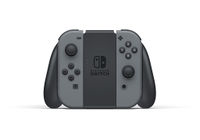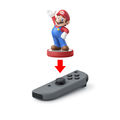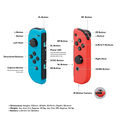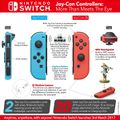| Site Notice |
|---|
|
We have a limited coverage policy. Please check our coverage page to see which articles are allowed. |
Joy-Con
| Joy-Con | ||||||||
|---|---|---|---|---|---|---|---|---|
| ||||||||
|
The Joy-Con (Joy-Con (L) and Joy-Con (R)) are the primary controllers for the Nintendo Switch. Their main feature is their versatility, able to be used as a singular controller both attached or detached from the Nintendo Switch itself and a controller grip, or as individual controllers.
Features and functionality
The Joy-Con are a pair of controllers that can be used as both a singular controller or as two controllers. The Joy-Con can be attached to the Joy-Con Grip (HAC-011) or the system by locking into the rails on both sides, or independently from both by holding them in each hand.[1][2]
The controllers feature the same buttons in an asymmetrical layout. Each Joy-Con has an analog control stick that can be pressed, a set of "face buttons" (the standard A/B/X/Y buttons on Joy-Con R, and a set of d-pad buttons on Joy-Con L), and a digital shoulder button and trigger button on the back. The backs of the Joy-Con also feature buttons to remove the Joy-Con from the Nintendo Switch or Joy-Con Grip. On the tops are the plus (Joy-Con L) and minus (Joy-Con R) buttons. On the side are player indicator LEDs, a pair of additional "SL" and "SR" shoulder buttons when using the Joy-Con as individual controllers, and a sync button to connect the controllers to the console when held[1][3] that also acts as a power button when pressed.[4] A pair of Joy-Con Straps (HAC-014) can also be attached, which feature a wrist strap in addition to the SL and SR buttons and player LEDs.
Both Joy-Con have built-in accelerometers and gyroscopes for more advanced motion control.[1] Another new feature of the Joy-Con is "HD Rumble", a more advanced form of haptic feedback powered by Immersion Corporation's "LRA" (linear resonant actuator) technology, allowing users to feel more precise sensations.[1] Joy-Con L features a new Capture Button, which allows users to capture screenshots of gameplay and share them on social media.[1] Joy-Con R also has a built-in NFC reader and writer,[1] and its bottom is an IR camera which can detect the shapes of objects and their distance from the Joy-Con.[3][1]
The Joy-Con use a rechargeable lithium-ion battery (HAC-006[5]) which lasts for up to 20 hours at full charge. The Joy-Con can be charged by attaching them to the Nintendo Switch system (regardless of whether or not it is charging), or by using the Joy-Con Charging Grip (HAC-012).[1]
Gallery
Using amiibo with the Joy-Con.
Trivia
- The name "Joy-Con" was derived from the word "enjoy".[6]
- An earlier iteration of the system used magnets to attach the Joy-Con for handheld mode, but this was changed to the rail design as the magnets would easily separate.[6]
- An early design for the Joy-Con Grip attached the controllers in a "V" shape. This was changed to the current, "parallel" design to make it easier to use.[6]
- Following the launch of the Nintendo Switch, a number of users reported issues regarding the left Joy-Con loosing connectivity when used wirelessly. According to Nintendo, the Joy-Con connectivity problems were the result of a "manufacturing variation", which has since been resolved.[7]
External links
References
- ↑ 1.0 1.1 1.2 1.3 1.4 1.5 1.6 1.7 Nintendo Switch Presentation 2017. Nintendo (YouTube; January 12, 2017). Retrieved January 13, 2017.
- ↑ First Look at Nintendo Switch. YouTube (Nintendo; October 20, 2016). Retrieved October 20, 2016.
- ↑ 3.0 3.1 Features on the official Nintendo Switch website. Retrieved January 13, 2017.
- ↑ Video: Nintendo Switch Controllers All Have a Power Button Hiding in Plain Sight. Nintendo Life (May 4, 2017). Retrieved May 5, 2017.
- ↑ Random Time! - User showcases the inside of a NIntendo Switch JoyCon. GoNintendo (February 28, 2017). Retrieved February 28, 2017.
- ↑ 6.0 6.1 6.2 5 Things You May Not Know About Nintendo Switch – Nintendo Minute Video. Nintendo (YouTube; February 24, 2017). Retrieved February 25, 2017.
- ↑ Nintendo Says JoyCon Wireless Issues Were Caused By 'Manufacturing Variation'. Kotaku (March 22, 2017). Retrieved March 24, 2017.
|
|












